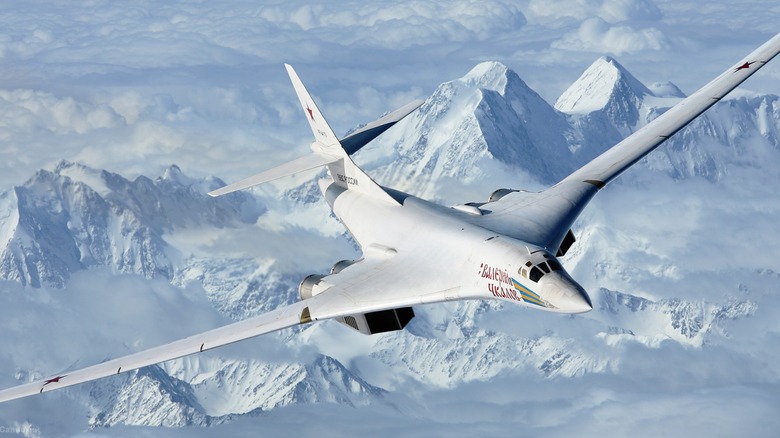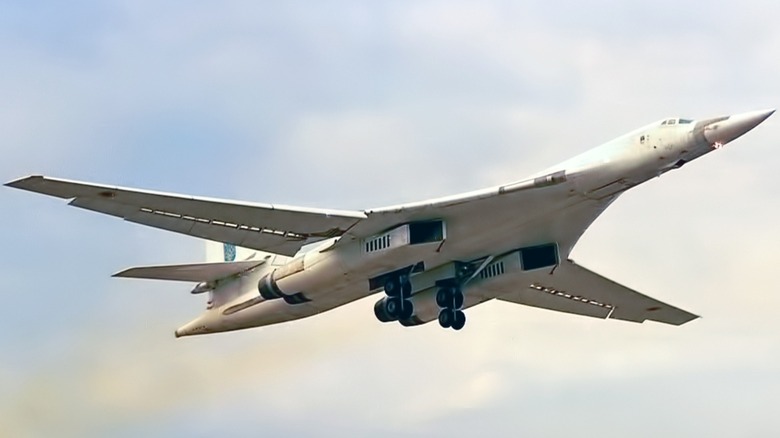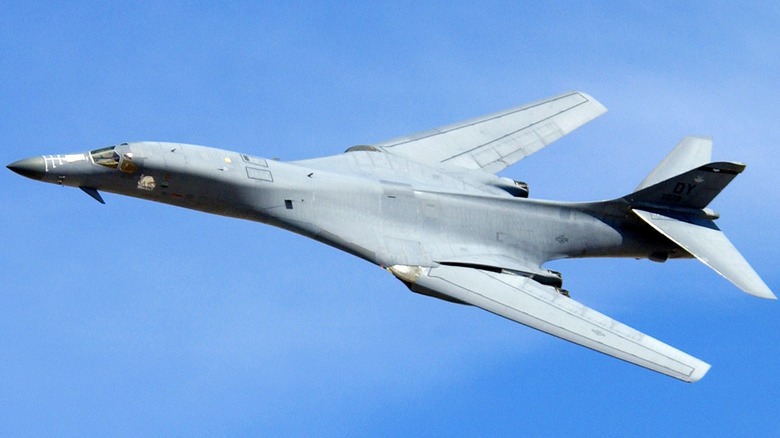Which Military Bomber Carries The Largest Payload?
Bombers have essentially been around since the earliest days of aviation. It didn't take long for people to realize that dropping explosives from high altitudes caused widespread damage. As early as World War I, soldiers began dropping weapons from an internal bay or throwing small bombs out of their open-cockpit biplanes. As technology improved, bombers became even greater assets.
There are many modern strategic bombers in service, designed to deliver as many bombs as possible, but the one that boasts the largest payload isn't from the United States: It's a 1980s-era monster first developed in the Soviet Union. The Tupolev Tu-160 (known as "Blackjack" in NATO) is the heaviest bomber ever made. The aircraft that most closely rivals the Tu-160 in the U.S. is the B-1B Lancer, which may have a lower payload and top speed but comes with its own advantages. For one, the Lancer has seen a lot more combat than the Tu-160, which experienced its first operational use in 2025.
The Tu-160 outperforms the U.S. B-1B Lancer on many fronts
The United States designed the B-1B Lancer — nicknamed "The Bone" — in the 1970s as a deep-penetration strategic bomber with a large payload capacity. The Soviets took notice and in response developed the Tu-160, which was first flown in 1981 but didn't enter service until 1987. On paper, the Tu-160 is significantly more impressive than the B-1B, with a payload that exceeds the U.S. bomber by more than 10,000 pounds.
With a maximum takeoff weight of 606,271 pounds, the Tu-160 is the heaviest and largest combat aircraft ever made. It can achieve Mach 2.05 (1,572.9 mph) thanks to its four Kuznetsov NK-32 afterburning turbofan engines. (For comparison, the B-1B bomber has a top speed of Mach 1.2, or 920.7 mph.) Since its debut in the 1980s, the Tu-160 has even been upgraded to improve its range to 7,640 miles and its payload capacity to 88,185 pounds.
In addition to nuclear weapons, the Tu-160 can also carry and launch cruise missiles, extending its range significantly. Originally, 35 of these bombers were produced, but Russia has expanded the manufacturing plant where Tu-160s are made and is working to produce more. In June 2025, Russia started using its existing Tu-160s in Ukraine, marking the bomber's first operational use since its introduction.
The B-1B Lancer does have some advantages over the Tu-160
The Tu-160 has a greater payload capacity and is faster than the B-1B, but both bombers can refuel in the air to have virtually an unlimited range. What sets the B-1B apart from the Tu-160, mainly, is the variety of ordnance it can carry. While it was originally designed to be able to take nuclear weapons into combat, this capacity was removed in the 1990s. However, it has a long history of delivering various bombs and other munitions to targets all over the world.
The B-1B can carry 84 500-pound bombs, 24 2,000-pound bombs, or 8 2,000-pound Quick Strike naval mines. It can also carry 30 cluster munitions of various types, or 30 Wind-Corrected Munitions Dispensers. It can also deliver up to 24 2,000-pound or 15 500-pound Joint Direct Attack Munitions (JDAM). In terms of missiles, the B-1B can fire up to 24 AGM-158A Joint Air-To-Surface Standoff Missiles, along with many other deadly devices. All in all, the U.S. Air Force has been flying the B-1B for over 40 years, and it's proven to be a reliable, strategic asset. This gives it an edge over the Tu-160, which has rarely been used.


